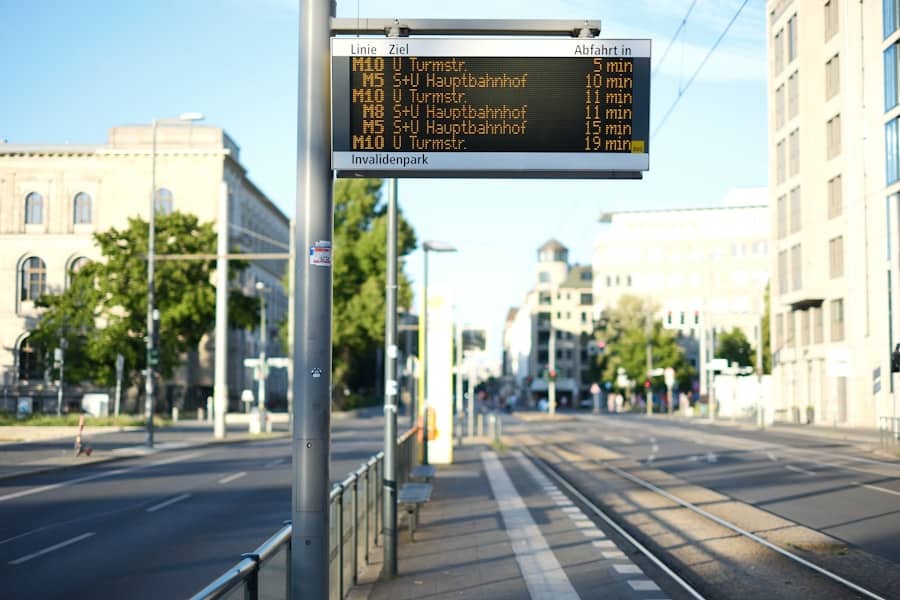The electrification of public transport systems represents a significant stride toward reducing greenhouse gas emissions and mitigating climate change. Traditional diesel-powered buses and trains contribute substantially to urban air pollution, emitting nitrogen oxides, particulate matter, and carbon dioxide. In contrast, electric vehicles (EVs) produce zero tailpipe emissions, which can lead to improved air quality in densely populated areas.
For instance, a study conducted by the International Council on Clean Transportation (ICCT) found that transitioning to electric buses could reduce greenhouse gas emissions by up to 70% compared to their diesel counterparts, depending on the energy mix used for electricity generation. This shift not only benefits public health by decreasing respiratory diseases linked to air pollution but also contributes to broader climate goals by reducing reliance on fossil fuels. Moreover, the environmental advantages of electrification extend beyond immediate emissions reductions.
Electric public transport systems can be powered by renewable energy sources such as wind, solar, and hydroelectric power. This integration can further diminish the carbon footprint associated with public transportation. For example, cities like San Diego have begun to harness solar energy to power their electric bus fleets, demonstrating a commitment to sustainability that aligns with global efforts to combat climate change.
The cumulative effect of these initiatives can lead to a significant decrease in urban heat islands and improved biodiversity in metropolitan areas, as cleaner air and reduced noise pollution create more livable environments.
Key Takeaways
- Public transport electrification can significantly reduce greenhouse gas emissions and air pollution, leading to a positive environmental impact.
- Technological advancements such as improved battery technology and charging infrastructure are driving the electrification of public transport, making it more feasible and efficient.
- Government policies and incentives play a crucial role in promoting public transport electrification by providing financial support and regulatory frameworks.
- Public transport electrification can lead to cost savings and economic benefits in the long run, through reduced fuel and maintenance costs.
- There is a growing public demand for sustainable and eco-friendly transportation options, making public transport electrification a popular choice among commuters.
Technological Advancements Driving Public Transport Electrification
The rapid advancement of battery technology is one of the primary drivers behind the electrification of public transport. Lithium-ion batteries, which have seen substantial improvements in energy density and cost-effectiveness over the past decade, are now capable of powering electric buses and trains for longer distances without frequent recharging. Innovations such as solid-state batteries promise even greater efficiency and safety, potentially revolutionizing the public transport landscape.
For instance, companies like Proterra have developed electric buses that can travel over 300 miles on a single charge, making them viable alternatives to traditional diesel buses for urban transit systems. In addition to battery technology, advancements in charging infrastructure are crucial for supporting the widespread adoption of electric public transport. Fast-charging stations are being deployed in strategic locations throughout cities, allowing electric buses to recharge during layovers or while passengers board and disembark.
This innovation not only enhances operational efficiency but also reduces downtime for vehicles, making electric public transport more appealing to transit authorities.
Government Policies and Incentives for Public Transport Electrification

Government policies play a pivotal role in facilitating the transition to electrified public transport systems. Many countries have implemented ambitious targets for reducing carbon emissions and increasing the share of electric vehicles in their fleets. For example, the European Union has set a goal for all new public transport vehicles to be zero-emission by 2030 as part of its Green Deal initiative.
Such regulatory frameworks provide a clear roadmap for cities and transit agencies to follow, encouraging investment in electric infrastructure and technology. In addition to regulatory measures, financial incentives are critical for promoting electrification. Governments often provide grants, subsidies, or tax breaks to transit agencies that invest in electric vehicles and charging infrastructure.
The U.S. federal government has allocated billions of dollars through programs like the Low or No Emission Vehicle Program, which supports the purchase of electric buses and related infrastructure. These financial incentives can significantly lower the upfront costs associated with transitioning to electric fleets, making it more feasible for municipalities with limited budgets.
Cost Savings and Economic Benefits of Public Transport Electrification
While the initial investment in electric public transport may be substantial, the long-term cost savings associated with electrification are compelling. Electric vehicles typically have lower operating costs compared to diesel vehicles due to reduced fuel expenses and lower maintenance requirements. For instance, electric buses can save transit agencies up to 70% on fuel costs over their lifetime when compared to diesel buses.
This reduction is primarily attributed to the lower cost of electricity relative to diesel fuel and the fewer moving parts in electric drivetrains, which translates into less frequent repairs and maintenance. Furthermore, electrification can stimulate local economies by creating jobs in manufacturing, installation, and maintenance of electric vehicles and charging infrastructure. As cities invest in these technologies, they often require skilled labor for installation and upkeep, leading to job creation in sectors such as engineering and construction.
A report from the American Public Transportation Association (APTA) indicates that every $1 billion invested in public transportation generates approximately 50,000 jobs. By transitioning to electric systems, cities not only enhance their transportation networks but also bolster local employment opportunities.
Public Demand for Sustainable and Eco-Friendly Transportation Options
As awareness of climate change and environmental issues grows, public demand for sustainable transportation options has surged. Citizens increasingly prioritize eco-friendly alternatives when choosing how to travel within urban environments. Surveys conducted by organizations such as the Pew Research Center reveal that a significant majority of people support investments in public transportation that reduce emissions and promote sustainability.
This shift in consumer preferences is prompting transit agencies to respond by electrifying their fleets and enhancing service offerings. Moreover, the rise of social media and digital platforms has amplified public discourse around sustainability issues. Advocacy groups and community organizations are leveraging these tools to raise awareness about the benefits of electric public transport and mobilize support for electrification initiatives.
Cities that actively engage with their communities about sustainability goals often find greater public backing for electrification projects. For example, Los Angeles has seen increased ridership on its electric bus routes after launching campaigns highlighting the environmental benefits of these services.
Challenges and Barriers to Public Transport Electrification

Despite the numerous advantages associated with electrifying public transport systems, several challenges remain that can hinder progress. One significant barrier is the high upfront capital cost required for purchasing electric vehicles and installing charging infrastructure. Many transit agencies operate on tight budgets and may struggle to allocate sufficient funds for such investments without external support or financing options.
Additionally, the transition from diesel to electric requires careful planning regarding route optimization and charging schedules to ensure that service reliability is maintained. Another challenge lies in the existing electrical grid’s capacity to support widespread electrification. In many regions, especially those with aging infrastructure, there may be concerns about whether the grid can handle the increased demand for electricity from charging stations.
Upgrading grid capacity can be a complex and costly endeavor that requires coordination between transit agencies and utility companies. Furthermore, there may be regulatory hurdles related to permitting and zoning that complicate the installation of charging infrastructure in urban areas.
Global Examples and Case Studies of Successful Public Transport Electrification
Several cities around the world have successfully implemented electrified public transport systems, serving as models for others looking to make similar transitions. Shenzhen, China, is often cited as a leading example; it has converted its entire fleet of over 16,000 buses to electric power within just a few years. This ambitious initiative has resulted in significant reductions in air pollution and greenhouse gas emissions while also improving public health outcomes for residents.
In Europe, cities like Amsterdam have embraced electric trams as part of their public transport networks for decades. The city has invested heavily in renewable energy sources to power its tram system, ensuring that it operates sustainably while providing efficient service to residents and tourists alike. Additionally, London has introduced an extensive network of electric double-decker buses that not only reduce emissions but also enhance the city’s iconic image as a leader in sustainable urban transport.
Future Outlook and Potential Growth of Public Transport Electrification
The future of public transport electrification appears promising as technological advancements continue to evolve alongside increasing public demand for sustainable solutions.
Additionally, innovations such as autonomous electric vehicles may reshape how public transport operates, potentially increasing efficiency and accessibility.
Moreover, as governments worldwide commit to ambitious climate targets, funding for electrification initiatives is expected to grow. The global push toward net-zero emissions will likely drive further investment in clean transportation technologies across various regions. As cities recognize the economic benefits associated with electrified public transport—such as job creation and reduced operating costs—the momentum toward widespread adoption will likely accelerate.
In conclusion, while challenges remain in the path toward fully electrified public transport systems, the environmental benefits, technological advancements, supportive government policies, economic advantages, growing public demand for sustainable options, successful global examples, and an optimistic future outlook all contribute to a compelling case for continued investment in this transformative shift within urban transportation networks.
The global push towards sustainable energy solutions is gaining momentum, and one of the key areas experiencing rapid transformation is public transport electrification. This shift is driven by the urgent need to reduce carbon emissions and combat climate change. As cities worldwide invest in electric buses and trains, the benefits extend beyond environmental impact, including reduced noise pollution and lower operational costs. For those interested in the broader implications of technological advancements, an article on NFT images explores another facet of how digital innovation is reshaping industries. While seemingly unrelated, both topics highlight the transformative power of technology in modern society.
FAQs
What is public transport electrification?
Public transport electrification refers to the process of transitioning public transportation systems from traditional fossil fuel-powered vehicles to electric-powered vehicles. This can include buses, trains, trams, and other forms of public transportation.
Why is public transport electrification accelerating worldwide?
Public transport electrification is accelerating worldwide due to a combination of factors, including the global push to reduce greenhouse gas emissions, improve air quality, and decrease reliance on fossil fuels. Additionally, advancements in electric vehicle technology, declining costs of electric vehicles, and government incentives and policies are also driving the acceleration of public transport electrification.
What are the benefits of public transport electrification?
The benefits of public transport electrification include reduced greenhouse gas emissions, improved air quality, quieter and smoother rides for passengers, and decreased reliance on fossil fuels. Additionally, electric vehicles have lower operating costs and can contribute to energy independence and security.
Which countries are leading the way in public transport electrification?
Several countries are leading the way in public transport electrification, including China, which has the largest fleet of electric buses in the world, as well as European countries such as Norway, the Netherlands, and the United Kingdom, which have made significant investments in electric buses and trains. Additionally, cities like Los Angeles and New York in the United States are also making strides in electrifying their public transportation systems.
What are the challenges of public transport electrification?
Challenges of public transport electrification include the high upfront costs of electric vehicles and charging infrastructure, limited range and charging infrastructure for certain types of vehicles, and the need for supportive policies and regulations to facilitate the transition. Additionally, the disposal and recycling of batteries used in electric vehicles also present environmental challenges.

